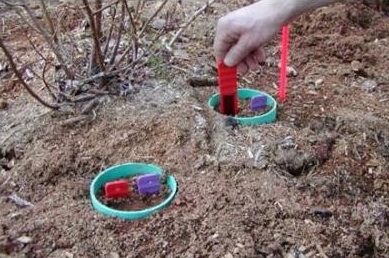
Features
Production
Research
Organic weed control options for blueberry
November 6, 2009 By Marg Land
 November 4, 2009, Truro,
November 4, 2009, Truro,
NS – Research scientists at Nova Scotia Agricultural College have been working
steadily to find effective organic methods to control weeds in cultivated
blueberry crops.
November 4, 2009, Truro,
NS – Research scientists at Nova Scotia Agricultural College have been working
steadily to find effective organic methods to control weeds in cultivated
blueberry crops.
One resulting study,
published in a recent issue of the American Society for Horticultural Science
(ASHS) journal HortScience, reported on the efficacy of three organic mulches
used on highbush blueberry (HBB) produced under organic production practices.
The research team determined that the major factor influencing weed suppression
by compost mulches (for certain weed species) was likely mulch thickness and
bulk density, which provide a barrier to weed growth and prevents light
penetration to the soil surface.
 |
|
| Researchers study mulching options for weed control at Blueberry Acres in Nova Scotia. |
Weeds are a widespread
problem for the blueberry industry. North American commercial blueberry
producers who took part in a recent survey indicated that weed problems were a
concern in almost all production areas, particularly in young plantings when
bushes are not fully established and most susceptible to competition. Weed
control is even more of a challenge for growers of organic products, including
organic highbush blueberry (Vaccinium corymbosum L.). The current study was
initiated as an attempt to find feasible, effective organic weed control
methods to sustain Nova Scotia’s growing blueberry industry.
A two-year field study was
conducted in 2005 and 2006 in an established field of five-year-old northern
highbush blueberry at Blueberry Acres, a commercial blueberry operation in the
Annapolis Valley of Nova Scotia. Mulches, applied in-row at a 20-cm depth,
included pine needles, manure-sawdust compost, and seafood waste compost.
Dr. Derek Lynch, of the
Department of Plant and Animal Science at NSAC, headed the research team.
According to Dr. Lynch, organic materials such as pine bark, peat, and sawdust
are commonly used as a preplant soil amendment to increase the organic matter
content of mineral soils, but heavy applications of organic mulch can result in
high soil salinity and impact plant yield and growth, even resulting in
environmental impacts.
“Alternately, thickly
applied organic mulches may be an effective weed management option,” noted Dr.
Lynch. “Mulch thickness is an important consideration because the emergence of
weed seedlings is inversely related to seed depth, meaning the efficacy of weed
control tends to increase with mulch thickness.”
The study reported that
pine needles (PN) were the most effective mulch in suppressing weed growth,
with 55 per cent less and 73 per cent less aboveground weed biomass compared
with the control in 2005 and 2006, respectively. Pine needle productivity
effects were much more modest, however. One year after application, pine
needles lost some efficacy at suppressing weeds but the treatment was still
superior to both composts. The researchers recommend continuing to top dress PN
or similar mulches on a yearly basis to maintain mulch thickness.
“This approach can be
cost-effective depending on local availability of mulch materials,” said Dr.
Lynch. “However, precautions should be taken to avoid excess nutrients from
heavy application of nutrient-rich mulches and weed-seed contamination of these
types of mulch.”
He added that more
research is needed to evaluate the long-term effects of different mulches on
productivity and nutrient availability in these systems.
Print this page